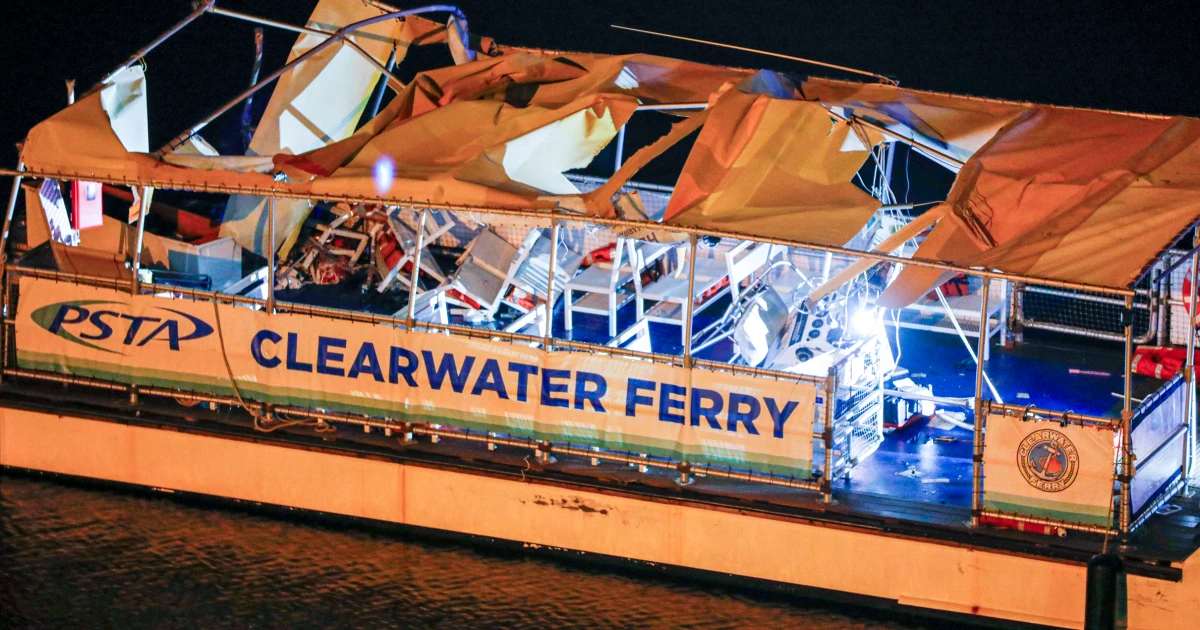clearwater ferry accident
Introduction
On April 27, 2025, a deadly collision between two boats caused the waters near Clearwater, Florida to become very turbulent, disrupting a peaceful ferry ride. Soon after returning home from the Sugar Sand Festival, the 37-foot powerboat the Wave Chaser and the 40-foot Clearwater Ferry collided, resulting in a tragedy. The result was catastrophic, a man died, others were hurt and it inspired many investigations, lawsuits and public anger.
This article looks closely at the events, those involved, the legal processes, how the public responded and the impact on boating safety laws.
The Scene of the Collision
About 8:43 p.m. on October 29, 2009, the Clearwater Ferry was headed east underneath the Memorial Causeway Bridge. The weather was bright and everything was easy to see which made water travel good. There were many passengers on the boat, some with families, others with partners and some alone, who were coming back from Clearwater’s big local event.
Without any notice, a recreational boat driven by Jeffry Knight crashed into the back of the ferry. A big impact was heard first, leading to panic as individuals were thrown out of their seats, everyone could hear the sound of screams and many suffered injuries on the spot. Because of the damage and instability, the ferry beached itself onto a nearby sandbar.
Authorities called it a mass casualty incident shortly after the event. Rescue teams used boats, helicopters and emergency cars to rescue people, treat those hurt and help frightened passengers.
Fatalities and Injuries
Jose Castro, aged 41 and from Palm Harbor, was killed in the collision. People described Castro, who was a husband and father, as someone full of joy who made everyone around him happy. The community was upset by his death which raised questions about accountability and safe practices on boats.
Apart from the death, 10 people were hurt such as kids and a woman who was expecting a child. A number of passengers had broken bones, concussions and injuries related to trauma. Airlifts were required for two critical cases, whilst the rest of the injured were attended to and treated where they were found.
Even so, just the physical injuries were not the whole issue. Many people who survived shared how much emotional distress they went through lack of sleep, frequent panic and fear of being near the water again.

The Role of Jeffry Knight
A recreational powerboat tragedy put Jeffry Knight, the boat’s operator and owner, in the public and legal spotlight. Many people have testified that Knight’s boat failed to slow down and did not try to avoid a collision with the ferry before hitting it.
Once the incident occurred, witnesses say that Knight drove away and left. A few hours after the crash, the authorities found his vessel in Belleair which is several miles from where the plane went down. Later, he stated that his boat was taking on water and he had to escape to stay safe, but some people think escaping after causing a deadly accident was very irresponsible.
The breathalyzer test allegedly found that Knight was not impaired by alcohol. Prosecutors decided not to conduct a blood test which drew criticism from both the victims and legal experts. Lack of a complete toxicology report began to cause tension as the case unfolded.
Legal Actions and Investigations
Not long after the incident, people who were injured and Jose Castro’s family began to look into what legal actions were possible. The first person to bring legal action was Nicole Makelele, who was hurt in the crash. The suit says Knight operated the boat without care, was speeding and failed to give proper attention ahead of the crash. The suit claims that Knight left the scene without taking steps to help the injured.
Knight’s lawyers stated that the boat had poor lighting which made it difficult to steer and the passengers and captain were distracted by dolphins in the water. Many survivors say this explanation is both insulting and distracting, as they insist the ferry was behaving lawfully and was easy to spot.
Florida Fish and Wildlife Conservation Commission (FWC) handled the official inquiry. Witnesses were interviewed, the team inspected both ships and they looked over nearby security camera videos. As late May 2025 showed, there had been no charges filed yet, but the case was still being actively investigated.
Captain and Crew Response
Captain Dennis Kimerer, who was in charge of the ferry during the crash, gave a public interview a few days after what happened. The airline’s statement highlighted how the crew and passengers helped each other during the trouble and remained calm throughout. He showed concern to the Castro family and promised to help with the investigation.
She pointed out that the company followed every safety and operating rule, like making sure all lights were on and the boat travelled at the proper speed. He rejected claims that the ferry was negligent and claimed that he and his crew acted effectively after the accident.

Public Outcry and Community Support
Local people acted fast and with great passion after the tragedy. Celebrations were set up to make sure Jose Castro was never forgotten. Neighbors of the families sent donations and planned meetings where the community talked about water safety and wanted the laws for boaters to be more strict.
Parents of victims went on local TV and talked openly about how their children were injured. They spoke up about being irritated by how slowly the investigation moved and the little responsibility shown by the suspect. Various parties argued for better laws on boating accidents such as blood analyses for all drivers involved in major incidents and tougher punishments for abandoning the site of a crash.
There were many online petitions that recorded thousands of supporters asking for action and new policies. Groups promoting maritime safety agreed and pushed further to enforce the laws after the tragedy.
Resumption of Ferry Service
In May 2025, Clearwater Ferry customers were able to use a different vessel after the regular ferry was repaired. The ferry company has assured the public that ensuring safety is their biggest concern and has promised to assist with the continuing investigation. The original ferry that was part of the crash did not go back into service until it was inspected and fixed.
At first, people returned to travel and sightseeing in a cautious way. The company improved safety by training crew members more and updating the emergency communication system.
Implications for Boating Safety Laws
The Clearwater Ferry accident underscored several critical gaps in maritime safety enforcement. Among the issues raised were:
- Lack of mandatory toxicology testing: for operators involved in fatal accidents.
- Inconsistent regulations: on boat lighting and navigation at night.
- Insufficient penalties: for leaving the scene of an accident on water.
- Limited surveillance coverage: of open water routes, complicating investigations.
Lawmakers in Florida began drafting proposals to address these issues, and several local leaders expressed support for legislation that would close these gaps. Some suggested the use of GPS trackers and black-box devices on larger recreational boats to help reconstruct incidents.
Emotional and Psychological Toll
While the medical team deals with the injuries after the accident, it will take much more time for the emotional consequences to fade. According to survivors, they started having flashbacks, fearing water travel and experienced post-traumatic stress disorder (PTSD). Victims could use counseling services given by local agencies and community groups, though many of them wished for more long-term support for their mental health.
In particular, the family of Castro has found it hard to get through this experience. People say Jose was a pleasant and reliable man, whose family was the center of his life. Besides causing emotional difficulty, his death has also led to financial difficulties for those who cared for him.
Conclusion
Because of the clear cut nature of the accident, many remember April 27, 2025, as a day when one moment’s mistake changed lives forever. There was one death, several injuries occurred and the whole community was left grieving and full of anger.
Even during the investigations and proceedings, it’s obvious the fire was not simply an accident, but it acted as a warning. It pointed out major dangers in waterways, encouraged the public to demand accountability and set off a push for stricter boating rules.






